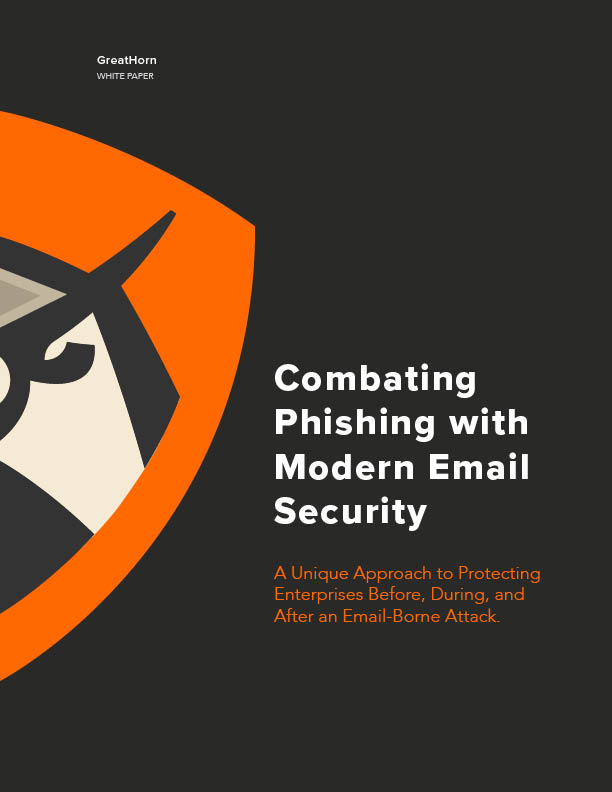In this third and final part of our blog series on Combating Phishing with Modern Email Security, we review the attributes of modern email security and provide a checklist for evaluating modern email security solutions.
But first, a recap of Part 1 and Part 2. The cybercriminals who create evasive social engineering attacks aim to exploit three core weaknesses:
- Conventional, good/bad systems don’t often catch the more advanced threats like executive or brand impersonations. These types of emails mimic “regular” mail so well that to spot them, systems would also in turn block vast amounts of “regular” mail.
- Many companies treat email security as a distinct point-in-time solution rather than a strategic, comprehensive program. Today’s sophisticated threats require a holistic approach – balancing business processes, people, and technology. The over-reliance on the perimeter-based blocking technology combined with disconnected and often ineffective security training programs often results in a code red situation.
- Humans are not the weakest link, but are underutilized assets. Given the right context at the right time, it turns out that people can be a highly effective layer of defense.
Today’s threat landscape requires a reimagining of how technology addresses email security—blocking more threats at the platform level, yes, but also identifying additional points of protection at the user level, and better tools at the administrator level to further reduce risk and mitigate damage.
Email security isn’t merely “basic blocking and tackling” for your enterprise.
Today, email-based threats including malicious links, attachments, spear phishing campaigns, and business email compromise are among the most-used tools of cybercriminal groups and nation-state actors. These types of attacks that often evade detection can be trojan horses for larger, more serious compromises like unauthorized money transfers, credential theft, and even the destruction of key systems and data. The growing sophistication of email threats demands a new approach to email security. Legacy email threat detection platforms that merely scan inbound messages for spam and malicious attachments are blind to stealthy, “low and slow” attacks like business email compromise.
When evaluating email security solutions, please keep the following features in mind: adaptive threat detection, user engagement through contextual cues, and integrated incident response capabilities.
Adaptive Threat Detection
Your email security solution should offer superior and dynamic detection of both known and emerging threats. The recent emergence of ransomware has raised the stakes for detecting malicious software before it has a chance to spread in your environment. Take a close look at your vendor’s threat detection capabilities and ask about how it handles new and emerging threats or whether it supports the signature-less detection of generic threats. Malware like wipers and remote access trojans (RATs) are just one aspect of email security. Your email security should also leverage threat intelligence to get a jump on emerging command and control (C2) infrastructure, suspect senders, spear phishing campaigns and other targeted campaigns. Make sure your email security platform is informed by robust threat intelligence.
User Engagement through Contextual Cues
Many inbound messages fall into a gray area between “clean” and “suspicious.” Therefore, arming your employees with the proper threat awareness and education is vital. Your email security software should reinforce those lessons: helping to highlight suspicious elements of messages in ways that allow the end user to make the best decision about whether a given message is suspicious or legitimate.
Integrated Incident Response
Bad actors are likely to target more than one individual inside your organization and execute multiple avenues of attack. Detecting and deleting new threats is just the first step in protecting your organization. Your email security platform should also provide you with robust incident response features that let you build out from any detection to quickly remediate similar threats across your messaging infrastructure. If wider investigations are warranted, your messaging platform should provide the tools to do robust incident response to email-borne threats and attacks.
Thank you for reading our blog series on how modern email security can protect organizations before, during, and after an email attack. If you haven’t yet read Part 1 and Part 2, you can binge read the series by checking out the downloadable version.
 GreatHorn protects organizations from more advanced threats than any other email security platform. By combining its highly sophisticated threat detection engine with accessible user context tools and integrated incident response capabilities, GreatHorn Email Security shields businesses from both sophisticated phishing attacks and fast moving zero-day threats, freeing security teams from the tedium of email security management while enabling them to respond to genuine threats faster than ever before.
GreatHorn protects organizations from more advanced threats than any other email security platform. By combining its highly sophisticated threat detection engine with accessible user context tools and integrated incident response capabilities, GreatHorn Email Security shields businesses from both sophisticated phishing attacks and fast moving zero-day threats, freeing security teams from the tedium of email security management while enabling them to respond to genuine threats faster than ever before.
By combining deep relationship analytics with continuously evolving user and organizational profiling, GreatHorn’s cloud-native email security platform provides adaptive, anomaly-based threat detection that secures email from malware, ransomware, executive impersonations, credential theft attempts, business services spoofing, and other social engineering-based phishing attacks.




